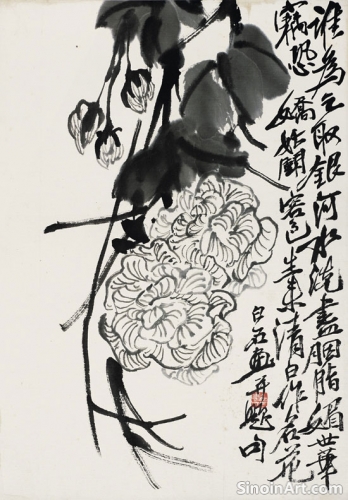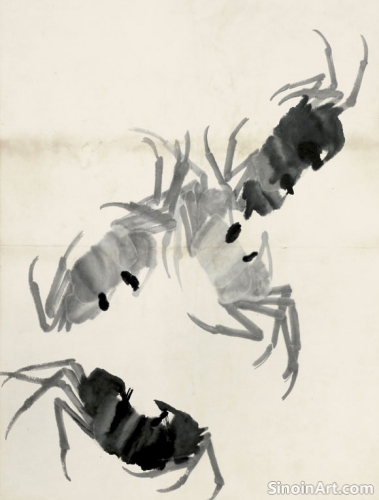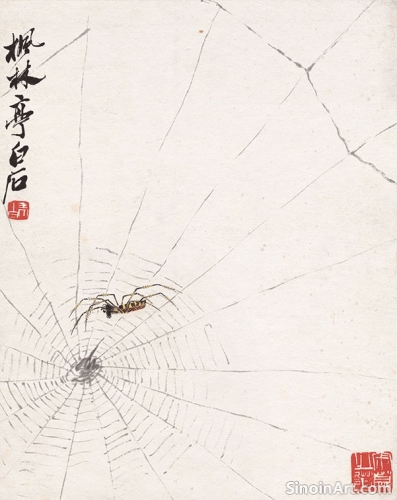The History and Evolution of Xieyi
|
The roots of Xieyi painting can be traced back to the Song Dynasty (960-1279), when scholar-officials began to use painting as a means of personal expression rather than merely as a decorative art form. This shift was closely linked to the development of Chan (Zen) Buddhism, which emphasized intuition, spontaneity, and direct experience. Artists like Su Shi and Mi Fu, known for their literati paintings, pioneered the use of calligraphic brushwork to express inner feelings and the rhythms of nature.  Over the subsequent dynasties, Xieyi evolved and diversified, with different schools and masters adding their unique perspectives. During the Yuan Dynasty (1271-1368), artists retreated from political life, finding solace and expression in landscape painting, often using Xieyi techniques to create works filled with a sense of longing and introspection. The Ming Dynasty (1368-1644) saw the emergence of individualistic artists like Xu Wei, whose bold and unrestrained style challenged convention, and laid the groundwork for the more radical approaches.  The Qing Dynasty (1644-1912) witnessed further innovation, with artists incorporating new subject matter and experimenting with different ink washes. Bada Shanren, for example, used exaggerated forms and unusual compositions to express his deep sense of turmoil and resistance. His unique and highly recognizable style, though very distinct, is grounded in the freehand brushwork that typifies Xieyi. The late Qing period also saw the introduction of Western art techniques, which, while not directly impacting Xieyi, prompted a dialogue and re-evaluation of traditional methods.  The 20th century saw a continued exploration of Xieyi, with artists like Qi Baishi and Pan Tianshou adapting its traditions to modern contexts. Qi Baishi, known for his lively depictions of insects, birds, and everyday objects, combined traditional techniques with a highly personal approach. Pan Tianshou emphasized the structural aspects of painting, creating powerful compositions with dynamic brushstrokes and bold use of ink. Their influence continues to resonate with contemporary Xieyi painters. Today, Xieyi remains a vibrant and evolving tradition. Contemporary artists are pushing the boundaries of the style, incorporating new materials, techniques, and subject matter while still remaining true to the core principles of spontaneity, expression, and the pursuit of the essence of things. The historical legacy of this art form, which is still being written, serves to deepen our understanding of the cultural, philosophical, and artistic significance of Xieyi painting. |
Tag : History of Xieyi painting, Song Dynasty art, Yuan Dynasty landscape, Xu Wei artist, 20th-century Xieyi
Related information
- Common Subjects in Xieyi Painting
- The Influence of Confucianism on Xieyi
- Xieyi Painting and the Depiction of Trees
- The Ink of Xieyi: A Palette of Grays
- The Importance of "Qi" in Xieyi Brushwork
Common subjects in Xieyi painting include bamboo, plum blossoms, landscapes, birds, flowers, and animals, each imbued with symbolism and representing aspects of nature and the artist's inner world.
Confucianism subtly influences Xieyi painting through its emphasis on self-cultivation, social harmony, moral conduct, and the ideal of the gentleman scholar, shaping the cultural context, the values of the art form, and the ethical dimensions of artistic creation.
Trees are a powerful subject in Xieyi painting, depicted through expressive brushwork and washes to capture their unique forms, textures, and symbolic representations of longevity, growth, resilience, and the connection between the human and natural realms, conveying both beauty and a profound appreciation for the cycles of life.
This article focuses on the significance of ink in Xieyi painting, exploring its tonal variations, preparation process, and application techniques, emphasizing its role in capturing the essence of a subject.
Qi (vital energy) is fundamental to Xieyi brushwork, representing the expressive quality and energy within each stroke, achieved by the artist's balance, focus, and connection with their subject, emphasizing spontaneity and imbuing the artwork with a sense of vitality and inner spirit.